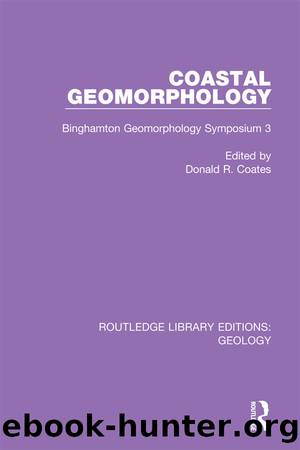Coastal Geomorphology by Coates Donald R.;

Author:Coates, Donald R.; [COATES, DONALD R.]
Language: eng
Format: epub
Publisher: Taylor & Francis Group
Published: 2020-03-05T00:00:00+00:00
The Agulhas Current and coastal currents
Because the southeasterly trade wind circulation of the central Indian Ocean produces a major hydraulic head against the east African coast, the South Equatorial Current diverges and major components flow southward both east and west of Madagascar. These currents converge off northern Zululand to form the warm Agulhas Current, the direction and position of which are subsequently determined largely by the shape of the coastline and the continental shelf. The Agulhas Current flows southward parallel to the coast throughout the year as a comparatively well defined stream, 50-75 km wide, with velocities of 1.0 to 2.5 m/sec, and a volume of flow which varies from 25-60 million m3/sec (Fig. 4). The western edge of the Agulhas Current generally flows near the edge of the continental shelf, the distance of the current offshore correlating significantly with the atmospheric pressure gradient.
Wave motion along the western edge of the Agulhas Current generates an eddy circulation between the current and the coast, which appears offshore as a system of reversing coastal currents. Though coastal currents have long been recognized (viz. Africa Pilot, v. Ill, 12th ed., 1967), only recently have their complexities been examined and explanations sought.
The coastal currents flow parallel to the shore with near-surface velocities of 0.2-0.8 m/sec, reduced by a factor of 0.3-0.4 near the seabed (Oliff, 1969; Oliff and Addison, 1970; Anderson et al, 1970). Off southern Zululand, these currents flow alternately NE and SW, reversing direction periodically at 1-3 day intervals. These reversals appear linked with changes in atmospheric pressure, allowing for a variable lag of 3-36 hours. Off Richards Bay and Port Durnford, the overall exchange of water is slow, northerly, and offshore. At Richards Bay, mean monthly velocities average 0.3 m/sec and onshore currents occur on 10-60 percent of occasions. At Port Durnford and farther south, current reversals are common in both summer and winter, velocities for north-flowing and south-flowing currents average 0.2 m/sec, and onshore components occur on 10-30 percent of occasions, Summer reversals seem to follow short-term changes in atmospheric pressure. Winter reversals are random.
Coastal currents are much stronger and more persistently south-flowing off northern Zululand. The mean monthly velocity at Cape St. Lucia in summer is 0.4 m/sec south-flowing, and the extreme range is 0.6-0.8 m/sec. Winter measurements indicate more north-flowing currents than in summer. Nevertheless, the overall current is strong and south-flowing 80 percent of the time, with onshore components on 10-50 percent of occasions. This strong flow suggests that the main Agulhas Current impinges on the coast as far south as Cape St. Lucia, then diverges southward allowing eddies to develop on the widening continental shelf. Off the St. Lucia Estuary, the main current is 5 km offshore, south-flowing 50 percent of the time, with onshore components on 30 percent of all occasions.
These coastal currents constitute a basically simple system responding to energy changes imposed by atmospheric pressure variations. Their driving energy presumably comes from the main Agulhas Current and is consistent with a large-scale periodic wave motion induced upon a steady south-flowing system.
Download
This site does not store any files on its server. We only index and link to content provided by other sites. Please contact the content providers to delete copyright contents if any and email us, we'll remove relevant links or contents immediately.
The Lonely City by Olivia Laing(4568)
Animal Frequency by Melissa Alvarez(4148)
All Creatures Great and Small by James Herriot(3986)
Walking by Henry David Thoreau(3681)
Exit West by Mohsin Hamid(3634)
Origin Story: A Big History of Everything by David Christian(3472)
COSMOS by Carl Sagan(3346)
How to Read Water: Clues and Patterns from Puddles to the Sea (Natural Navigation) by Tristan Gooley(3239)
Hedgerow by John Wright(3106)
How to Do Nothing by Jenny Odell(3101)
The Inner Life of Animals by Peter Wohlleben(3099)
How to Read Nature by Tristan Gooley(3077)
Project Animal Farm: An Accidental Journey into the Secret World of Farming and the Truth About Our Food by Sonia Faruqi(3018)
Origin Story by David Christian(2991)
Water by Ian Miller(2950)
A Forest Journey by John Perlin(2915)
The Plant Messiah by Carlos Magdalena(2745)
A Wilder Time by William E. Glassley(2689)
Forests: A Very Short Introduction by Jaboury Ghazoul(2671)
